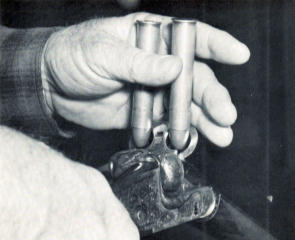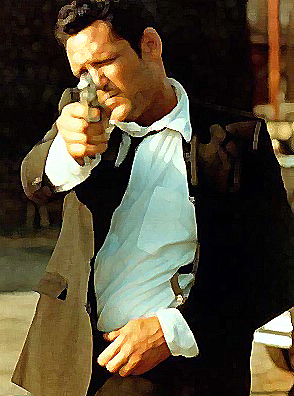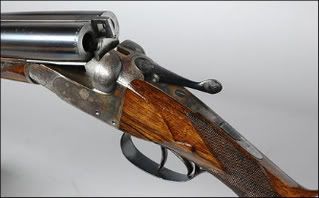

 The Accurate Reloading Forums
The Accurate Reloading Forums  THE ACCURATE RELOADING.COM FORUMS
THE ACCURATE RELOADING.COM FORUMS  Rifles
Rifles  Double Rifles
Double Rifles  What to look out for when buying a double?
What to look out for when buying a double?Go  | New  | Find  | Notify  | Tools  | Reply  |  |
| one of us |
Aside from features that one may prefer on their particular rifle, what can the eye of a fairly inexpert viewer look out for on a double, what needs to be looked at, what can you physically do to check little things on a doublebefore comiting to buying? Basically what are the tell tale sign of weakness and age? | ||
|
| one of us |
The name and address of an expert to do a proper exam. At least if you are looking at one of the "classic" old DRs. Keith IGNORE YOUR RIGHTS AND THEY'LL GO AWAY!!! ------------------------------------ We Band of Bubbas & STC Hunting Club, The Whomper Club | |||
|
One of Us |
Having an expert in DRs (not just any old gunsmith) hast o be done, but doing that will cost a few bucks. There are a number of things that you should know what to look for prior to sending it to the expert. First, see if it is on face. The way I do it is remove the forend of the rifle, turn it upside down, move the top lever over and gripping the rifle by the wrist and the barrels, see if there is any wiggle in the action. This is a good way to see if a rifle is on face. Close the action and see if there is any light between the barrel flats and water table, or breech face and barrels. Look for cracks on the stock. Check for stressed rifling! Remove the barrels and hold them up to a light source. Barrels with stressed rifling with have a "wavy" appearance on the outside. Check out the bores. See if the rifling is sharp the entire length of the barrel. Look for pitting and frosting in the grooves. Those are the big things to look for. I'm sure the experts will chime in with other things to look for. 577NitroExpress Double Rifle Shooters Society Francotte .470 Nitro Express  If stupidity hurt, a lot of people would be walking around screaming... | |||
|
| One of Us |
#1 - make sure your wallet is fat or that you have the winning lottery ticket | |||
|
| One of Us |
If you haven't studied fine double guns extensively to begin with, that's not an easy question to fully answer on a forum - and double rifles are more complex to evaluate than double shotguns. To hit the high points: 1. Original quality. This is where personal experience is of the most help. Take the time and effort to educate yourself as much as possible here. If you're not comfortable with your ability to judge original quality of fine double guns, get help. Doesn't have to be a "best" gun, but you don't want a JABC either. 2. Condition. When you're buying a used fine double rifle, you're buying a pair of barrels. Replacing them will usually cost more than a comparable gun in good condition is worth. Bore condition needs to be good, and the barrels undamaged. An off face condition can be a simple problem to fix, but it can also accompany permanent damage that isn't. Also, make sure the wood is solid. Restocking a fine double rifle correctly is second only to new barrels in cost. 3. Fit and function. Be sure that it fits you, or can be easily modified so that it does. If not, it isn't the right one. A double rifle really needs to fit correctly. It should also shoot and function correctly. Never buy a used double rifle without shooting it to test function and regulation first. Find one that looks to be of good quality, in good condition, and that you like. For what they cost, trust me, it needs to turn your crank. After that, DON'T try to do the rest yourself. Evaluating a fine used double rifle is more complex than for a double shotgun, and is not a do-it-yourself job. Your offer should be clearly contingent on a full evaluation (including shooting) by a gunmaker with DR expertise. If the seller has a problem with that, move on.
Not really the right choice of words - more like "abuse and excess wear." Not to be flippant but, since you need to ask the question, look for what's obvious and then send it on to your gunmaker to find out what you missed. There is no substitute for hands on experience here. ----------------------------------------------- "Serious rifles have two barrels, everything else just burns gunpowder." | |||
|
| One of Us |
After you have learned all you can on your own, send the gun to Champlin's in Enid, OK and have them look it over. They are the best experts on all types that I have come across. They have saved a friend of mine a bunch on money on a double that was poorly repaired. | |||
|
| One of Us |
Look out for double rifle addiction. If you own a gun and you are not a member of the NRA and other pro 2nd amendment organizations then YOU are part of the problem. | |||
|
| One of Us |
I hope that this does not sound too much like a "Double Gun 101"! 1) ON THE FACE - remove the forend. Hold the gun by the stock in right hand and about minway down the barrels in the left hand. Try to "bend" the thing, very gently. You are trying to test it not wreck it! As if it were an iron bar in a circus strong man act. Then try to twist the barrels whilst still maintaining the same grip. There should be absolutely no movement at all in any of it. It should be as if the whole thing were indeed one solid bar. 2) BARRELS - hang the barrels by the front loop from the forefinger of the left hand OR from a piece of string. Strike the barrels midway with the knuckle of the right hand forefinger. Not so much that you knock them out off your left forefinger and drop them. They should ring like a tubular bell. If they don't suspect a loose rib. 3) EJECTORS - over the thigh. Most people test ejectors by operating the gun in the usual way. As if they had just fired it. This is WRONG! It won't show faults in ejector timing. Load the gun with sanp caps or fired cases. Fire the gun. Place the gun over the thigh holding it there by the barrels with the joint resting on the thigh. Operate the top lever and pull the stock down just enough to open it but NOT eject the cases. Now gently with the knuckle of the right forefinger tap the heel of the but. This will keep lowering the butt by a fraction of an inch. This way you will reach the exact point that the ejectors "set"...you'll hear the click...and then another tap or so and they BOTH should go off together. The secret...slowly, slowly...that way if there is the slightest error in timing one WILL be see to go off before the other. 4) THE LOOP - by eye. Guns can be tightened by the right way and the wrong way! The right way is either by replacing a worn cross pin OR by building up metal on the front of the loop. The wrong was? You don't want to know! Here they are...by hitting the rear of the front loop and driving it forward, by peening the front edges of the loop, by putting the action in a vice and squeezing it! By peening with a punch the rear of the cross pin. All can, to one degree or another, be noticed by careful visual inspection...or at least you had better hope so! 5) THE FURNITURE (STOCK/FOREND) - by feel and eye. On any English double gun the wood should stand above...or "proud"...of the metal. Only a fraction, a "hair's width", but such that it can both be seen and felt. It should not be level with it or below it. It should be above it. The only exception being the front "pipe" on the forend and any oval in the stock which should be at the same level as the wood. If the wood around the rear of the action - boxlock, or around the lockplates - sidelock, is not raised or "proud" the stock has been refinished. 6) OTHER POINTS Check that the wood is not oil rotten. That happens when a gun is over oiled and the oil soaks through the firing pin holes as the gun is standing in the cabinet into the action and thence to the wood. 7) SAFETY CATCH - by test. Push the safety to "OFF" or "FIRE". Fire one barrel. Put the safety back on. Pull the trigger of the other barrel. It should not fire! Push the safety to "OFF" or "FIRE". Now pull that same trigger again. Gun should fire. Repeat but the other way around. Exactly as above. 8) STRIKERS - with a coin. Diassemble the gun. Hold a brass coin over the strker hole and pull the trigger. Repeat for other barrel. This will show you the two strikers and show if the ends are round, the protrusion is correct and the strength of the blow they strike. Re-cock the action by pushing the "dogs" against a door frame or similar wood surface. Some vendors don't like this done BTW! Hope this helps. All standard "drill" here in UK when buying any side-by-side, rifle or gun. Others will say look to see if light can be seen under the barrel flats or that the gun should not close on a bank note etc., etc. Discount these! Some guns are 110% but will still do or have both "faults"! Others will say hold the barrels to the ear and tip them back and forwards like a see-saw. Again sometimes you will hear what are small beads of solder running up and down the space between the ribs. Usually this is not a problem...sometimes it is a sign of something that does need to be investigated further. | |||
|
One of Us |
Very impressive! Thanks for this. | |||
|
| One of Us |
Good basic overview, but I'll have to disagree here:
Good way to test lock-up, which should be done to be sure, but it doesn't really help much in detecting an off face condition. On modern, conventional hammerless drop-down barrel action guns, "on face" has to do with the precise mating of the barrels to the action. "Off face" results from excessive wear to those mating surfaces only. The locking mechanisms have nothing to do with "on/off face" - they are a separate issue entirely, and can only hold the action of an on face gun shut. They can't prevent the movement of the barrels on the action during firing in a gun that is off face. However, the typical locking mechanisms - double underbolts and the third bite that many double rifles will have (especially so the screw type) - CAN mask an off face condition with the action locked. Consequently, checking "on/off face" is done with the action UNLOCKED. With the fore-end removed, hold the gun upside down (gravity helps you hold the gun tightly shut). Hold the barrels in the left hand, and the hand of the stock in the right, while holding the top-lever all the way open with the right fore-finger. If any movement at all is detected with this method, the gun is off face. If no movement is then detected with the action locked, it doesn't matter. It's off face, and needs to be repaired. Express: The details of what to look for are useful. They can save you the cost of insured shipping both ways to your gunmaker, as well as his fees, on those that will end up being culls. They're worth studying up on. At the same time, don't get bogged down in 'em - you'll pick it up along the way. What's important is that you don't skip the gunmaker step, and accept that there can be issues with double rifles that very, very few non-professionals have the expertise to catch. A couple of examples... Proof marks. Most double rifles have been built in Britain and Europe, where national proof laws are the rule, and will bear standardized proof marks. Those built elsewhere are a drop in the bucket. You'll need help here if you are not truly expert. If the proof marks indicate a problem, and you need to sit down with the rifle in front of you and open a book - your chances of catching it are zero. Some years ago, I ran across a DR that looked really nice. Many wouldn't have noticed that it had been re-bored and re-chambered to a larger caliber. Of course, this results in thinner barrel walls than the gun was originally proved with - which are pretty thin in double rifles to begin with. Not necessarily a fatal problem - you just send it to the proof house, re-proof is conducted and, if successful, new marks indicating re-proof are impressed. The gun is then "in proof" and safe to shoot with the cartridge that it was reproved for. The marks on this rifle indicating reproof had been faked. They were good enough to fool most experienced double rifle shooters - as they did the buyer - but not good enough to fool an expert on proof marks. A lovely, expensive rifle - that blew up. Another guy I know bought a lovely used DR. The rear V was so deep that it was almost even with the top of the rib, making it difficult to pull the front bead down into the bottom of the V without it fuzzing out, and it still shot somewhat high. He sent it off to his gunmaker to have taller front and rear sights fitted. The gunmaker looked down the barrels carefully and immediately noticed that it shot high because the barrels were slightly BENT. He very successfully straightened them and it shoots great, but talk about something getting missed! ----------------------------------------------- "Serious rifles have two barrels, everything else just burns gunpowder." | |||
|
| Powered by Social Strata |
| Please Wait. Your request is being processed... |
|
 The Accurate Reloading Forums
The Accurate Reloading Forums  THE ACCURATE RELOADING.COM FORUMS
THE ACCURATE RELOADING.COM FORUMS  Rifles
Rifles  Double Rifles
Double Rifles  What to look out for when buying a double?
What to look out for when buying a double?

Visit our on-line store for AR Memorabilia

